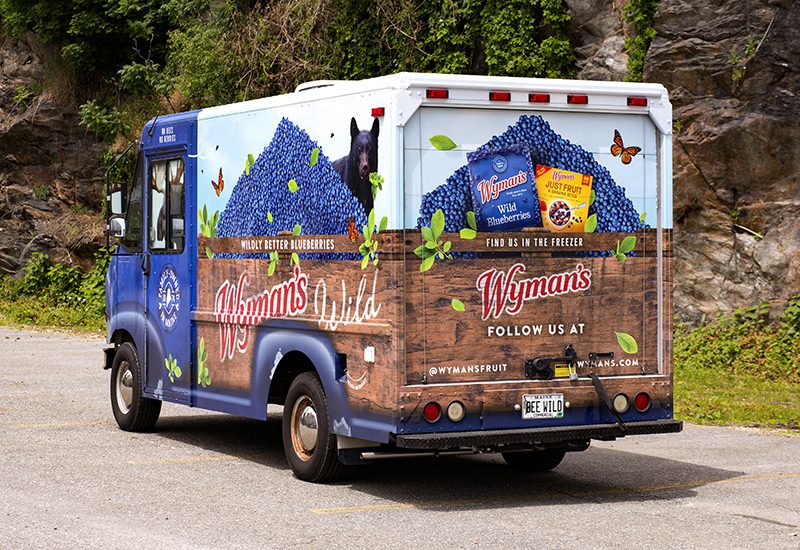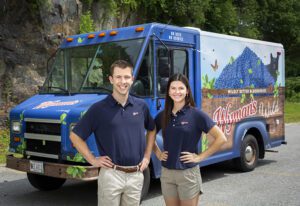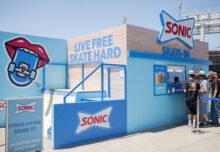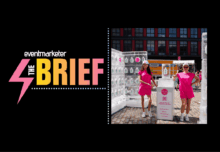Every event campaign yields lessons learned, something frozen fruit brand Wyman’s, which just wrapped its second-ever mobile tour, can attest to. From June to October, the brand was on the road in its blueberry-covered Bee Wild Mobile, and for the first time, ventured beyond its home state of Maine. Along the journey, Wyman’s hit different markets and events around New England spanning street festivals, road races, film festivals, fairs and retail events on a mission to build brand awareness and educate consumers on its products and purpose.
This year’s tour was operated by two former Oscar Mayer Hotdoggers, Colin Jay and Taylor Gray, who were charged with capturing ample social content, dishing out samples of Wyman’s frozen Just Fruit Cups, directing consumers to retail locations with coupons, pitching local media on the campaign and, most importantly, delivering brand messaging that connected the dots between wild blueberries, Wyman’s and the importance of consuming enough fruit. (Last year’s program was run by a former Hotdogger and former Planters Peanutter. Read about it here.)
At each event, the brand ambassadors engaged attendees in a fruit-themed dice game that yielded a slew of branded premiums, as well as a video “confessional,” which served as a recording of their first experience tasting Just Fruit Cups. Information on Wyman’s efforts to develop educational resources around pollination was also part of the mix.
Ultimately, Wyman’s planned to develop a national tour powered by a fleet of Bee Wild Mobiles, but scale doesn’t happen overnight. So we sat down with Wyman’s brand manager, Colleen Craig, to learn how the company used its first tour to inform this year’s program, the importance of going slow and steady in the race to build awareness and the power of a test-and-learn strategy. Following are her top 10 takeaways.
 More Brand-Building Strategies:
More Brand-Building Strategies:
- How Truly Hard Seltzer is Leveraging Toronto’s Summer-long Market to Drive Trial and Awareness
- Five Ways to Nurture a Dedicated Brand Community
1. Take baby steps.
With one mobile tour already under its belt, Wyman’s could’ve been tempted to charge full speed ahead toward its national tour aspirations in year two. But the brand recognizes the importance of building awareness and scale incrementally and intentionally.
“It’s trying to take it one step at a time, building toward that moment when we roll into town, and everyone knows Wyman’s is obsessed with fruit,” says Craig. “We’re trying to get people to eat more fruit every time we come to town, but we need to take these baby steps now where it’s like, wild blueberries. And then Wyman’s. And then fruit.”
2. Build loyalty from the ground up.
Wyman’s has learned that brand loyalty should be built from the ground up. If you can turn your employees into brand evangelists, the sentiment is likely to have a ripple effect in the marketplace.
“In our Downeast community (a term for parts of Maine and Canada’s Maritime Province), where a majority of Wyman’s employees live and work, there’s such pride in Wyman’s, and they get so excited by the Bee Wild Mobile,” says Craig. “So it’s starting from within to build ambassadors literally from our employees, and then their communities, and then Maine, and then people who love Maine. We’re still in that mode where it’s very community-focused—we’re in Maine’s high-traffic, tourist-focused areas—and then broadening throughout New England to trial and learn now so that when we eventually go bigger, we’ve got those learnings under our belt.”
3. Try, try again.
No marketer gets it right the first time, especially when it comes to experiential marketing. And Craig says her team has embraced the concept of trial and error and experimenting with different engagements, products, markets and event types to determine what resonates best with consumers. Boiled down, “trial and learn” is Wyman’s overarching event marketing strategy.
“We look at the vehicle in general as an opportunity for us to trial and learn with new products. So our Just Fruit Cups are out,” Craig says. “We also have eight products in the pipeline right now that are all fruit-forward, healthy convenience, some frozen, some shelf-stable. So the Bee Wild Mobile is looked at as a perfect vehicle to be able to trial and test whether or not consumers really have an appetite for said product.
“We also gave our brand ambassadors a huge range of events to try. Every day was a bit different. So by year three or four, we’ll have a much more structured approach of, OK, these five event types work really well for us, here are the markets that we need to hit, let’s lay it out and go from there.”
4. Solicit direct consumer feedback on-site.
If you really want to know how consumers feel about a product, you’ve got to ask them outright. It’s a strategy that was embedded in the Bee Wild tour to turn attendees into what Craig calls a “mobile focus group.” Before pitching a new Just Fruit Cup SKU to retail partners, Wyman’s leveraged its sampling events to gauge interest in its Coconut Bites product alongside its Banana Bites cups, which are already distributed nationally by Walmart.
“This is a chance for the ambassadors to sample this new flavor and get some on-the-ground, direct consumer feedback of, would you buy this flavor?” Craig says. “We had all these events booked in different markets, different venue types, with different individuals. So we were able to get a good cross section of people to taste the product and say, ‘What do you think?’ Or give them the option—are you going to choose Coconut Bites or choose Banana Bites?”
View this post on Instagram
5. Consider the logistical challenges.
The logistical challenges that crop up on mobile tours vary, and for a frozen fruit brand like Wyman’s, keeping massive quantities of products chilled became the biggest hurdle to expanding this year’s tour.
“The logistics of sampling of frozen product with a high melt factor is huge,” Craig says. “The vehicle carries 1,200 cups. We really wanted to stretch and do bigger events this year, but that required the logistics of getting cold storage in the zip code where we were sampling… That has an impact on scaling really big, really fast.”
6. Level-up your media outreach strategy.
Media partnerships are integral to boosting brand and campaign awareness, so Wyman’s tasked its brand ambassadors with upping the ante on media outreach this year.
“We learned how important amplification is to the program, so we had our ambassadors, who are media trained and experts on pitching media, doing a lot more outreach,” says Erin Sastre, marketing coordinator at Wyman’s. “We wanted to get more coverage for the Bee Wild Mobile, and especially get the word out and the community involved in out-of-state events. Media presence was definitely one of the things that we wanted to improve upon this year.”
7. There’s such a thing as too much swag.
Too much event swag? Yes, it’s possible. As much as consumers love freebies, there’s a point where giveaway options can be overwhelming for attendees, and an unnecessary expense for brands. Along this year’s Bee Wild mobile tour, attendees could snag items including t-shirts, hats, Stonewall Kitchen’s wild blueberry jam (made with Wyman’s products), key chains, pins, stickers and bandanas.
“It was almost too much,” Craig says. “Last year, we wanted to do everything to see what works and what people responded to. And this year we had seven different giveaways, and people were like, ‘I can take one of all of this?’ So as we go forward, we need to get a little bit more strategic. People love free things. But we don’t need to give them seven free things each time they come out.”
8. Map back to larger organizational messaging.
Wyman’s walks the walk when it comes to protecting the environment—the brand has become a national leader in bee conservation and hopes to amplify its efforts through events. Because, as the company puts it, “Every single fruit we harvest, and one third of the produce on our planet, owe their very existence to the pollinating efforts of bees.” And the brand’s mission to get people to eat more fruit, whether Wyman’s products or not, was also integrated into its on-site messaging.
“First and foremost, it’s making sure we’re trying to get people to eat more fruit. So it’s getting them [to try] Just Fruit Cups,” says Craig. “And then if they have an interest around working lands and pollination, it’s the whole discussion around ‘no bees, no berries’ and educational resources… We’ve worked with the KidsGardening network to develop resources around pollination. So not only are you getting a sample, but it’s also this much bigger experience around Wyman’s wild blueberries, our love of fruit and then the working lands of where this fruit comes from.”
9. Spread the wealth.
Sharing is caring within the experiential marketing industry. And Wyman’s is all about it. This year, the brand teamed up once again with L.L.Bean, this time to celebrate the brand’s 10th anniversary at its Maine headquarters, where Wyman’s parked right next to another well-known vehicle, the Bootmobile.
“Experiential is such a niche community within marketing, and we have a really nice working relationship with the Bootmobile in Maine, the other prominent Maine brand,” Craig says. “We have connections with the Nutmobile, and obviously we’ve hired Hotdoggers from the Wienermobile. So it’s great to be able to talk to people that are on the ground and share learnings. It’s nice to be able to partner up.”
10. Small details matter.
During last year’s mobile tour, Wyman’s brand ambassadors noted that the majority of attendees they interacted with took pictures of the Bee Wild Mobile’s license plate. So this year, the brand turned the license plate into a keychain and handed it out as free swag. And it seems to be paying off. While at a restaurant on a remote island in Maine over the summer, Craig spotted a woman sporting the keychain on her backpack.
“I said, hey where did you get that key chain,” Craig recalls. “And she said, ‘Oh, from Wyman’s.’ And what a great fact that she said ‘Wyman’s’ and not just ‘some event.’ It was a great full-circle moment.”
Looking ahead to next year’s tour, Craig says gathering consumer feedback and testing out new markets and event types will continue to be critical. “It’s all part of, again, the trial and learning of what’s an activation that’s going to draw people in that’s easy and interesting for people of all ages, that also allows us to talk about fruit in a really fun, memorable way.”







